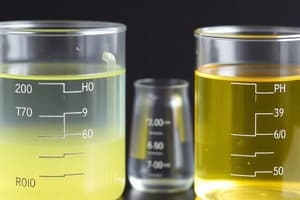Podcast
Questions and Answers
What is the primary function of buffer solutions?
What is the primary function of buffer solutions?
- To decrease the pH of a solution
- To neutralize all acids and bases in a solution
- To maintain a consistent pH level (correct)
- To increase the pH of a solution
How do buffer solutions neutralize the effects of added strong acids?
How do buffer solutions neutralize the effects of added strong acids?
- The conjugate acid of the weak base reacts with the hydrogen ions from the strong acid to form water.
- The hydrogen ions from the strong acid are absorbed by the buffer solution, preventing pH changes.
- The conjugate base of the weak acid reacts with the hydrogen ions from the strong acid to form the original weak acid. (correct)
- The buffer solution does not have any effect on the pH when strong acids are added.
What is the composition of a buffer solution?
What is the composition of a buffer solution?
- A strong acid and a strong base
- A weak acid and its conjugate base or a weak base and its conjugate acid (correct)
- A weak acid and a weak base
- A mixture of various acids and bases
Which of the following is NOT a common application of buffer solutions?
Which of the following is NOT a common application of buffer solutions?
What happens when strongly alkaline substances are introduced to a buffer solution?
What happens when strongly alkaline substances are introduced to a buffer solution?
Which of the following is NOT a characteristic of a buffer solution?
Which of the following is NOT a characteristic of a buffer solution?
What is the typical pH range of an acidic buffer solution?
What is the typical pH range of an acidic buffer solution?
Which of the following is an example of an alkaline buffer solution?
Which of the following is an example of an alkaline buffer solution?
What is the main purpose of a buffer solution?
What is the main purpose of a buffer solution?
Which of the following is NOT a characteristic of the conjugate acid-base pairs in a buffer solution?
Which of the following is NOT a characteristic of the conjugate acid-base pairs in a buffer solution?
What is the typical pH range of an alkaline buffer solution?
What is the typical pH range of an alkaline buffer solution?
Flashcards are hidden until you start studying
Study Notes
Buffer Solutions
Buffer solutions are a crucial component in maintaining a stable pH level in various applications. These solutions consist of a combination of a weak acid and its conjugate base or a weak base and its conjugate acid. By definition, a buffer is an aqueous solution capable of resisting changes in pH upon the addition of small amounts of acids or bases due to the presence of the acid-base pairs mentioned above. Let's explore some common buffer solutions further.
Common Buffer Solutions
Common buffer solutions can be categorized into two main types: acidic and alkaline buffers. Here are examples of each type:
Acidic Buffers
Acidic buffer solutions are those with a pH below 7, typically around 4.74. They consist of a weak acid and its salt mixed with a strong base. One example of an acidic buffer is a mixture of acetic acid and sodium acetate, which has a pH of about 4.75. The presence of the acetic acid and sodium acetate salt helps maintain the solution's pH by neutralizing small amounts of added strong acids or bases.
Alkaline Buffers
On the other hand, alkaline buffer solutions have a pH above 7, typically around 9.25. They contain a weak base and its salt mixed with a strong acid. An example of an alkaline buffer is a mixture of ammonium hydroxide and ammonium chloride, which has a pH of about 9.25. Similarly to acidic buffers, these solutions resist changes in pH upon the addition of small amounts of acids or bases due to their conjugate acid-base pairs.
Mechanism of Buffering Action
Buffers work by neutralizing small amounts of added acids or bases. When strong acids are introduced to a buffer solution, the hydrogen ions combine with the conjugate base to form the original weak acid, resulting in minimal change in the pH of the environment. On the contrary, when strongly alkaline substances are introduced to a buffer solution, the hydroxide ions react with the acids present in the solution to yield water molecules, thereby maintaining the pH.
In summary, buffer solutions play a vital role in maintaining a consistent pH level in various applications, such as fermentation, food preservatives, drug delivery, electroplating, printing, enzyme activities, and physiological systems. They consist of a weak acid and its conjugate base or a weak base and its conjugate acid. Understanding the properties and mechanisms of buffer solutions is essential for their effective use in scientific and industrial processes.
Studying That Suits You
Use AI to generate personalized quizzes and flashcards to suit your learning preferences.




